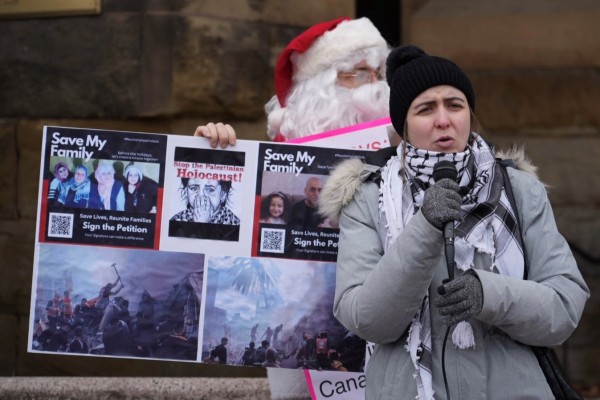Beyond an emergency
The ongoing refugee housing crisis in Toronto has shone a light on Canada’s lack of adequate supports for asylum seekers

Protesters gather outside a downtown Toronto intake centre to support refugees forced to sleep on the streets due to a lack of resources within the city’s shelter system. Photo courtesy the FCJ Refugee Centre.
The plight of Toronto’s homeless and the crisis in the city’s shelter system were on full public display when Olivia Chow took office as the city’s new mayor on July 12. For the previous six weeks, a growing number of refugees and asylum seekers had been camped outside Toronto’s Assessment and Referral Centre on Peter Street, sleeping on the sidewalks just blocks away from City Hall.
Beginning on June 1, with all shelters full to capacity, the city started referring refugees to federal programs for assistance. As federal programs that offer shelter are almost nonexistent in Toronto, many felt that the refugees on Peter Street were being used by the city as pawns in a funding stalemate with Ottawa. The contrast with the welcome that Ukrainian refugees received in Canada was hard to ignore, and the racist overtones were unmistakable.
Torontonians were shocked at this spectacle of dozens of newcomers, mostly from African countries, sleeping on the sidewalks for several weeks without adequate food, shelter, or access to washroom facilities. A refugee from Uganda was quoted as saying “I feel like I’m not welcome here.”
Enduring severe weather conditions, the asylum seekers were using cardboard boxes from a dumpster as blankets. They were camped out literally at the doorsteps of a city office designed to refer people in need to appropriate shelter or accommodation.
For a month and a half, no one from any level of government showed up to offer help or advice. Front-line workers, activists, refugee advocates, and even some small businesses did step up, however. Together, they provided the asylum seekers with a steady flow of food, clothing, tents, sleeping bags, and even some basic first aid. A crowdfunding site raised over $80,000 to purchase essential supplies.
This ad-hoc grouping also held a number of press briefings on the sidewalk to draw attention to this shameful spectacle. The most powerful of the press briefings was organized by the Black Community Housing Advisory Table and featured prominent leaders such as Jean Augustine, the first Black woman elected to the House of Commons, and Zanana Akande, the first Black woman to serve as an Ontario cabinet minister. The city’s African, Caribbean and Black communities mobilized resources and sheltered almost 600 refugees at three churches in north Toronto, where they would remain for weeks.
The situation on Peter Street made headlines for days and sparked a public outcry. Many raised questions about the substance of Toronto’s status as a “sanctuary city” (in 2013, Toronto became Canada’s first sanctuary city, meaning that undocumented immigrants are permitted to access services regardless of their status, without being reported to the federal government). Others asked why Canada is not more prepared to welcome an expected million-plus newcomers in the coming years.
Within days of taking office, Olivia Chow was able to broker a temporary deal with a chastened federal government, which pledged $97 million to fund more shelter spaces. At her first council meeting as mayor, Chow presented a motion to open 150 new shelter spaces immediately for refugee claimants and another 100 spaces as soon as possible. Another funding package of $14 million was negotiated between the province and the city to provide housing supplements for 1,350 individuals and families currently in the shelter system.
The asylum, shelter and housing issues dominated Chow’s first weeks in office. On July 28, she went to the churches sheltering refugees and apologized. She also said that the newly created shelter spaces were already occupied. She declared “the city is broke” and again appealed to the federal government “to take their responsibility seriously.” Federal Finance Minister Chrystia Freeland quickly rejected these calls for additional funding and said that the city should use its reserve funds. Justin Trudeau’s tone-deaf contribution, a day later, was to say, “I’ll be blunt. Housing isn’t a primarily federal responsibility.”
The Peter Street spectacle was not greeted with indifference in Toronto. Citizens, advocates, community groups, service agencies and faith organizations were outraged and responded quickly. The African, Caribbean and Black communities, as well as many other racialized communities and newcomers, were angry and hurt. Jean Augustine called it “deplorable” that people were sleeping in conditions she likened to a “a zoo on the side of the road.”
For over four months, several Black-led churches and community organizations continued to shelter and care for several hundred refugees. Chow even appealed to Toronto residents to open up their homes to asylum seekers.
Refugees continued to arrive in the GTA in large numbers, finding few designated shelter spaces and even fewer affordable housing options. City staff projected that the number of refugee and asylum seekers could climb to half of the city’s shelter capacity by year’s end.
The significant presence of asylum seekers ending up in Toronto’s homeless shelters is not new. It has been growing for the past decade. The number of refugees dropped during the pandemic, due to border restrictions, but is now back to a level it was in 2017. Governments have had several years to prepare for an adequate refugee-specific response.
By November, with all shelters still at capacity, almost 300 people were being turned away daily by central intake. About half were refugee claimants. Refugees and asylum seekers were back, once again, sleeping on downtown Toronto streets.
On November 2, faith leaders were back, once again, at Peter Street, holding another press conference and appealing for immediate action by government. A United Church minister described the scene of “asylum seekers living in front of encampments and shelters, in alleyways, in places all across the city, we estimate by the hundreds.”
The shelter system in neighbouring Peel Region is also at capacity and currently houses nearly 1,500 people, 1,200 of whom are refugees. On November 15, an asylum seeker from Nigeria was found dead in a tent located in an encampment in Brampton. His death was related to carbon monoxide from heating the tent.
Those who are unsheltered are also dealing with this year’s extreme weather. Reflecting on the situation that unhoused people are facing in Toronto, Rafi Aaron, spokesperson for the Interfaith Coalition to Fight Homelessness, described it as “beyond an emergency.”
Since June 1, advocates have suggested practical, immediate solutions for sheltering and for providing services for the newly arrived refugees. These have included making use of Metro Hall, Canadian National Exhibition buildings, or federal buildings such as the two armouries, coupled with services to support people with housing assistance, settlement services, support to access the labour market, and support for the processing of asylum claims. Reception centres at the airport and other key locations have been repeatedly suggested.
The Ontario Coalition of Service Providers for Refugee Claimants has called on all levels of government “to ensure that accommodations are available for newly arrived refugee claimants. These are individuals and families arriving in search of safety and protection, and we simply must not add to their suffering by refusing the fundamental human right for safe shelter.”
Instead, different levels of government have continued to shift the blame and spar over funding and responsibility.
The United Nations High Commissioner for Refugees (UNHCR) estimates that there are over 110 million ‘forcibly displaced’ people in the world today, including 36 million refugees and six million asylum seekers. These numbers are unprecedented. People are being displaced by wars, conflict, persecution, disasters, and climate change.
The majority of displaced people—76 percent—are not able to make it to high-income countries, but take refuge, instead, in neighbouring countries. The largest host countries for refugees are currently Turkey, Pakistan, Germany (the only high-income country among the top-10), Uganda, Russia, Poland, Sudan, Bangladesh, Ethiopia and Iran.
Canada is not on the frontlines of the global refugee crisis and is relatively insulated by geography. While Canada has welcomed just over one million refugees since 1980 (which includes those who have been resettled from overseas), on a yearly basis, only about 0.1 percent of the total number of displaced people in the world will end up in Canada. While Canada has ambitious immigration targets, its preference is always for economic immigrants. Canada has historically erected barriers for asylum seekers, as exemplified by the Peter Street debacle.
Peter Street is now known across the country and globally. It has put a spotlight on Canada’s lack of adequate supports for asylum seekers. It has also put a spotlight on the need for persistent advocacy and community organizing. It was no coincidence that the first to respond to the Peter Street crisis were front-line workers, activists and community organizations.
Toronto, and many other cities, have a long history of effective grassroots organizations pushing for change and having a significant impact. Advocates have engaged in tireless organizing, relentlessly pushing governments and decision makers for decades.
It has now been six months since Peter Street was thrust into the news. The lack of leadership and cooperation displayed by different levels of government is astounding. In one of the wealthiest countries in the world, we are relying upon ill-prepared faith and community organizations, staffed by volunteers, to do what the state should be doing—to welcome and to accommodate vulnerable, displaced people who have arrived here, often by a perilous journey, to seek a safe haven and to start a new life.
Ken Theobald is a community worker and activist in Toronto. He previously worked in the global education/international co-operation sector and was a board member with the Canadian Council for International Co-operation (CCIC), now called Co-operation Canada.










